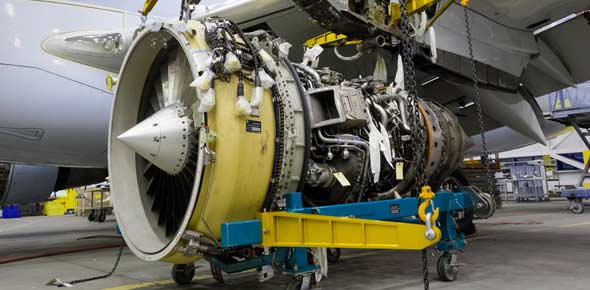(415) Gaps are permitted between a mechanical-lock blind rivet and the...
(419) You cannot cut cables by using a
(421) How do you remove foreign material from inside a completed...
(403) Which nut is used where the assembly is frequently removed and...
(401) How can you avoid stripping threads when installing a nut and...
(402) The fastener removal tool is primarily designed for use on a
(428) When is it permissible to reswage a Dynatube swage?
(413) Which of these tools is not required to remove a tight Jo-bolt...
(422) Which method would you use to bend a piece of tubing if a tube...
(403) What nut style do you use when all bolt hole locations are...
(417) If you find the nut plate is misaligned after installing it...
(419) A cable that has had a kinked area straightened
(403) You need to consider heat requirements for which prevailing...
(420) Which color designates aluminum alloy Air Force–Navy (AN)...
(422) What can you do to prevent thick-wall aluminum tubing from...
(424) While using the squaring- and burring-head assembly on the power...
(429) To inspect the ring position of a swaged Permalite (Deutschlite)...
(418) Which of the following is not a type of aircraft cable?
(423) For tubing flares to seat properly, they must be
(406) When drilling holes for fasteners you can maintain proper hole...
(408) When installing hi-shear rivets how do you accomplish proper...
(407) Cold-working hole expansion is used to prevent
(412) When riveting parts together the first step you take is to
(404) When a rigid type camloc receptacle needs to replaced you...
(406) How do you drill an interference fit hole for a fastener?
(418) What is the frequency of inspection when you substitute a...
(420) Which type of aluminum alloy tubing do you use to repair a...
(421) The probable cause of excessive burrs while cutting tubing with...
(425) To remove the tubing after you have finished making a flare with...
(407) When cold working a hole, which gage is used to verify the hole...
(411) What other problem besides centering can you eliminate by using...
(415) Which of these is not a procedure for drilling a mechanical-lock...
(419) In order to properly pull-test a cable, you keep the cable under...
(410) What material composition hi-lok fastener is used when the...
(431) When installing a fitting how much hydraulic pressure do you...
(422) To properly locate the start point on a piece of tubing that...
(426) When installing your military specification fittings which type...
(405) What part of an airloc assembly is never reused?
(409) The last step after installing pull-type lock bolts is...
(413) For best results Jo-bolt holes should be drilled
(403) The two major types of self-locking nuts you will install are
(428) Dynatube expanders designed for titanium are identified by stop...
(426) What is not used to preset a military specification sleeve onto...
(430) Which of these is not an inspection requirement for a Wiggins...
(431) How do you position a Rynglok© fitting on the tube before...
(412) When inspecting newly formed solid rivet shop heads what are the...
(418) Which cable term defines a cylindrical steel rod?
(418) What cable accessory is mainly used to change cable direction?
(416) How many nose assemblies are required to install Composi-Lok II...
(421) To be considered objectionable, the depth for a dent on a tubing...
(428) To properly make a Dynatube repair, you should have what degree...
(404) What is the final step that completes a camloc fastener assembly...
(413) What determines the twist drill size you need to remove a...
(416) After installation what tool do you use to inspect a Composi-Lok...
(411) The symbol on the bottom of a taper-lok pin represents the
(414) Which is not a step in removing a mechanical-lock blind bolt?
(401) When you are installing aircraft bolts in a panel you place...
(411) What head marking symbols on the taper-lok pins indicate that it...
(413) The next step after installing a millable Jo-bolt is to
(405) To properly install a new flush-type airloc turn-lock fastener,...
(420) The preferred tubing material for manufacturing external...
(427) To properly perform a Permaswage operation, you place the silver...
(409) What is the maximum surface angle on which you can...
(402) The most you should turn a screw with a screw punch tool is
(408) In determining the grip length of a hi-shear rivet, when it is...
(423) To correctly construct a single flare, you make the outside...
(418) A cable or wire rope twisted around a separate wire rope best...
(419) What is the maximum amount a terminal may be bent after swaging?
(427) To properly deburr a piece of tubing for a Permaswage repair,...
(424) To properly use the squaring- and burring-head assembly on the...
(414) To properly inspect an installed mechanical-lock blind bolt, you...
(429) The end marking template for a Permalite (Deutschlite) fitting...
(427) Once the chipless tube cutter makes light contact on the tube,...
(411) The second dash number stamped on the head of a taper-lok...
(424) To readjust the spindle on a powered flaring machine for another...
















